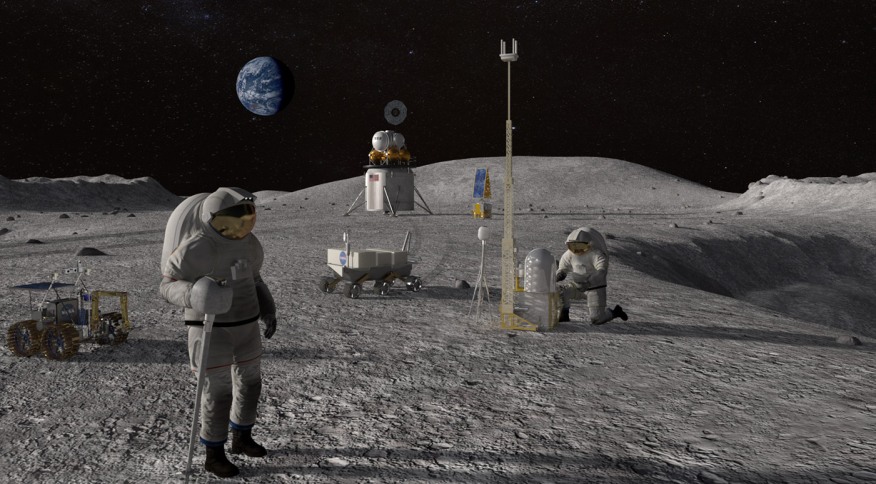The launch of Artemis I, an unmanned mission, which constitutes the ambitious first step of NASA to bring people back to Takes, until at least February 2022, according to the agency.
The launch was initially expected in November, however, with delays due to the Covid-19 pandemic, storms like Hurricane Ida, and other factors, delaying the mission schedule.
During the flight, the unmanned Orion spacecraft will be launched atop a Space Launch System (SLS) rocket to reach the Moon and travel thousands of kilometers ahead of it, more than any other spacecraft designed to transport humans has already traveled. This mission is expected to last a few weeks and end with Orion’s landing in the Pacific Ocean.
NASA said in the statement that the connection of Orion to the top of the SLS rocket occurred before midnight last Thursday (21), at NASA’s Kennedy Space Center, located in Florida, USA. United State.

“With the complete assembly and integration of the NASA Space Launch System rocket and Orion spacecraft, we are getting closer and closer to ushering in a new era of human exploration in deep space,” said NASA Administrator Bill Nelson.
“Thanks to the hard work of the design team, manufacturing, testing and final assembly of a new NASA rocket and spacecraft, we are in the final stage of preparations for the first launch of the Artemis I mission, paving the way for exploration of the Moon, Mars and beyond for many years.”
The mobile platform, 98 meters high in the Vehicle Assembly Building, is ready to enter the final testing phase ahead of the launch window that will open on February 12 and close on February 27.
This final step will include integration tests between Orion and the rocket before bringing the mobile platform to the launch pad. After that, the platform will undergo a final test called Wet rehearsal Or general fuel testing, which involves performing all propeller loadings on fuel tanks and counting down before launch. Basically, all the rituals needed to launch without actually doing it.
If this test, scheduled for January, is successful, the platform will return to the building until it is ready for actual launch.
After Artemis I’s unmanned flight, Artemis II will be a manned mission that will fly over the moon. Artemis III will take astronauts to the lunar surface, taking for the first time a woman and a black person. The release schedule for upcoming missions is based on Artemis I.
Tom Whitmaier, associate director of exploration systems development at NASA, said Friday (22). The missile itself was built on people from every state in the United States. It is a very important achievement for this country.”
Mike Sarafin, head of mission Artemis Eye, said that while the collection’s completion is an important milestone in the Expedition Headquarters extension, there are other challenging priorities ahead.
General fuel tests, or similar tests, are designed to ensure your Artemis I is fully prepared. Test results may change the release date.
“We intentionally set up a stress test for the Space Launch System rocket and our Orion spacecraft,” Sarafin said. “Our four main goals are: to demonstrate Orion’s ability to return from the Moon under conditions that allow re-entry to the Moon, to operate our flight systems and surroundings during flight, to recover our spacecraft, and then what I like to call additional targets.”
These additional targets include “fantastic images” that will be captured by the latest cameras installed on the far flanks of Orion’s solar system as it travels between Earth and the Moon, as it orbits the Moon, as well as back and land.
“Orion will take pictures of himself, and we will see the moon in the background and we are in the distance,” Sarafin said. “We’ll see Earth from about 275,522 kilometers away and really get a new perspective on the Artemis generation.”
In the end, the launch date will determine the duration of the mission. During the 15-day launch period in February, half of the days could be a larger, six-week, six-week mission, while the other days could mean a short mission of about four weeks.
If the launch is not in February, there are also chances that Artemis I will launch from the platform between March 12 and 27 and between April 8 and 23.
Orion program manager Kathy Corner said Artemis I will be Orion’s last test before the spacecraft takes astronauts to the moon, 1,000 times further from Earth than the space station.
“This will really prove the capabilities of our spacecraft and in much harsher radiation environments,” he said. “We’re looking forward to sending Orion to the Moon and seeing it perform in that environment.”
(Text translated from Spanish. Click Here to read the original)
Participate:

“Incurable thinker. Food aficionado. Subtly charming alcohol scholar. Pop culture advocate.”






More Stories
NASA Releases Selfie of Perseverance Rover Working on Mars
NVIDIA driver includes hidden Final Fantasy XVI profile
PlayStation Plus Extra and Premium saw a significant drop in players in July